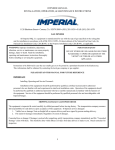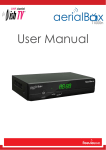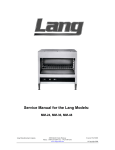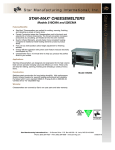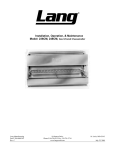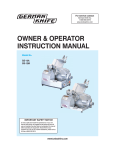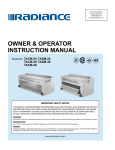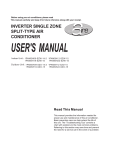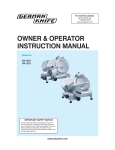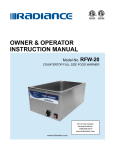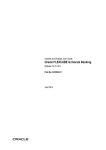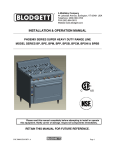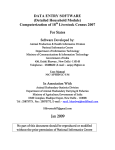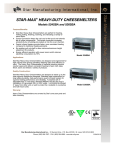Download OWNERS MANUAL INSTALLATION, OPERATION
Transcript
OWNERS MANUAL INSTALLATION, OPERATION, & MAINTENANCE INSTRUCTIONS ® 1128 Sherborn Street ▪ Corona, CA 92879-2089 ▪ (951) 281-1830 ▪ FAX (951) 281-1879 IR SERIES – RANGES & OVENS All Imperial Mfg. Co. equipment is manufactured for use with the type of gas specified on the rating plate and for installation in accordance with ANSI Z223.1/NFPA 54 (latest edition) of the National Fuel Gas Code, the National Gas Installation Code, CSA/B149.1 or the Propane Installation code, CSA/B149.1, as applicable. Copies may be obtained from the American Gas Association, 1515 Wilson Blvd, Arlington, VA 22209. WARNING: Improper installation, adjustment, alteration, service or maintenance can cause property damage, injury or death. Read the installation, operating and maintenance instructions thoroughly before installing or servicing this equipment. FOR YOUR SAFETY DO NOT STORE OR USE GASOLINE OR OTHER FLAMMABLE VAPORS OR LIQUIDS IN THE VICINITY OF THIS OR ANY OTHER APPLIANCE. Instructions to be followed in case the user smells gas are to be posted in a prominent location in the kitchen area. This information shall be obtained by contacting the local gas company or gas supplier. PLEASE RETAIN THIS MANUAL FOR FUTURE REFERENCE IMPORTANT Safe and satisfactory operation of your equipment depends to a great extent on its proper installation. Installation must conform to local codes, or in the absence of local codes, with the National Fuel Gas Code ANSI Z223.1/NFPA 54, the National Gas Installation Code, CSA/B149.1or the Propane Installation code, CSA/B149.1, as applicable. Imperial cooking appliances are restaurant grade. Ranges are free standing and available in widths from two to six feet. A large number of different range top arrangements are assembled over one or two ovens or a cabinet base. Installation is the same for any range top regardless of whether it has an oven below or not; in like manner, installation is the same for all cooking equipment regardless of the top arrangement. This unit may also be equipped with a salamander broiler. A Cheesemelter may be mounted on the high shelf as long as the Broiler is not wider than the range. IMPORTANT Installing, Operating and Service Personnel: Installation of the equipment should be performed by qualified, certified, licensed and/or authorized personnel who are familiar with and experienced in state/local installation codes. Operation of the equipment should be performed by qualified or authorized personnel who have read this manual and are familiar with the function of the equipment. Service of the equipment should be performed by qualified personnel who are knowledgeable with Imperial Ranges 1 SHIPPING DAMAGE CLAIM PROCEDURE The equipment is inspected & crated carefully by skilled personnel before leaving factory. The transportation company assumes full responsibility for safe delivery upon acceptance of this equipment. If shipment arrives damaged: 1. Visible loss or damage: Note on freight bill or express delivery and have signed by person making delivery. 2. File claim for damages immediately: Regardless of extent of damages. 3. Concealed loss or damage: If damage is noticed after unpacking, notify transportation company immediately and file “Concealed Damage” claim with them. This should be done within fifteen (15) days from date delivery is made to you. Retain container for inspection. GENERAL (1) A manual gas shut-off valve must be installed in the gas supply (service) line ahead of the appliance and gas pressure regulator in the gas stream for safety and ease of future service. (2) The gas pressure regulator supplied must be installed on the appliance prior to connecting the equipment to the gas line. Failure to install a regulator will void the equipment warranty and result in a potentially hazardous condition. (3) The appliance and its individual shut off valve must be disconnected from the gas supply piping system during any pressure testing of the system at test pressures in excess of ½ PSI. (4) The appliance must be isolated from the gas supply piping system by closing its individual manual shut off valve during any pressure testing of the gas supply piping system at test pressures equal to or less than ½ PSI. (5) Please contact the factory, the factory representative, or a local service company to perform maintenance and repairs. RATING PLATE The rating plate is located in front of the range below the oven section (7” from the floor). Information on this plate includes the model and serial numbers. When communicating with factory about a unit or requesting special parts or information, this data is essential for proper identification. Other information on this plate is the BTU/hr input of the burners, operating gas pressure in inches WC, and whether the unit is orificed for natural or propane gas. Pilot lighting instructions (ovens only) are also located in the same area. The Salamander broiler or Cheesemelter (if provided) is supplied with its own rating plate located on the unit. IMPERIAL COOKING APPLIANCES MUST BE CONNECTED ONLY TO THE TYPE OF GAS IDENTIFIED ON THE RATING PLATE CLEARANCES The appliance area must be kept free and clear of all combustibles. This unit is design-certified for the following installations only: The clearances from combustible and noncombustible construction for ranges and range mounted Salamander broiler or Cheesemelter are as follows: Combustible Back Sides Noncombustible 4” 10” 0 0 If legs or casters are not used, the unit must extend 2” beyond the front edge of a noncombustible curb or platform. 2 CAUTION DO NOT PUSH against the end of the valve cover/landing ledge in an attempt to adjust the ranges position. Although this part is deburred during manufacturing, an accident could occur if the range should move suddenly while being pushed into position by hand. HIGH SHELF ASSEMBLY (1) Mount the blackguard to the range with #10 sheet metal screws. (2) Mount the high shelf to the blackguard with #10 sheet metal screws provided (see attachment at the end of this manual for a diagram that describes the installation of the blackguard/flue riser). NOTE: If a Salamander broiler/Cheesemelter is to be mounted on range, read installation instructions for Salamander broiler/Cheesemelter before installing high shelf. Special care must be taken to ensure that the gas supply piping and/or gas pressure regulator is not exposed to exhaust gases or elevated temperatures. LEVELING A carpenter’s level should be placed on the center across the range top and the unit leveled both front-toback and side-to-side. If it is not level, cakes, casseroles, and any other liquid or semi-liquid batter will not bake evenly, burner combustion may be erratic and the unit will not function efficiently. Except griddles which need to slope forward 1/8” – ¼”. If the floor is relatively smooth and level, the unit may be further leveled with adjustment in the foot of the leg. Adjust to the high corner and level the unit with metal shims if the adjustment required exceeds the 1 ¼” adjustment available. Units with casters must be leveled with shims. A unit will probably not return to the same position after being moved, requiring re-leveling after each move. AIR SUPPLY & VENTILATION The area in front of, around, and above the appliance must be kept clear to avoid any obstruction of the flow of combustion and ventilation air. Adequate clearance must be maintained at all times in front and at the sides of the appliances for servicing and proper operation. Means must be provided for any commercial, heavy-duty cooking appliance to exhaust combustion waste products to the outside of the building. Usual practice is to place the unit under an exhaust hood. Filters and drip troughs should be part of any industrial hood, but consult local codes before construction and installing a hood. Strong exhaust fans in this hood or in the overall air conditioning system can produce a slight vacuum in the room and/or cause air drafts, either of which can interfere with pilot or burner performance and can also be hard to diagnose. Air movement should be checked during installation; if pilot or burner outage problems persist, makeup air opening or baffles may have to be provided in the room. CONVECTION OVEN – ELECTRICAL CONNECTION Imperial ranges with CONVECTION OVEN requires a 120 volt supply to operate the ignition systems and circulating fan. The supply cord provided on the appliance is equipped with a three prong (grounding) plug for protection against shock hazard. The electrical service in the building must be equipped with a properly grounded three prong receptacle, in accordance with local codes, or in the absence of local codes, with the National Electrical Code, ANSI/NFPA 70 or the Canadian Electrical Code, CSA C22.2, as applicable. Do not cut or remove the grounding prong from this plug. Wiring diagram is located on the backside of the side control panel. Disconnect power supply before cleaning or servicing. 3 NOTE: This appliance is not capable of being operated in the event of power failure. No attempt should be made to operate this appliance during a power failure. GAS CONNECTION NOTE: The gas supply (service) line must be the same size or greater than the inlet line of the appliance. Imperial ranges and ovens use a ¾” NPT inlet. Sealant on all pipe joints must be resistive to LP gas. MANUAL SHUT-OFF VALVE This installer –supplied valve must be installed in the gas service line ahead of the appliance and regulator in the gas stream and in a position where it can be reached quickly in the event of an emergency. PRESSURE REGULATOR All commercial cooking equipment must have a pressure regulator on the incoming service line for safe and efficient operation, since service pressure may fluctuate with local demand. The manual shut-off valve is normally supplied by the installer, however, a pressure regulator is packed inside each Imperial range. Failure to install a pressure regulator will void the equipment warranty The regulators supplied for Imperial ranges, have ¾” inlet/outlet openings and are adjusted at the factory for 5” WC (natural gas) or 10” WC (propane) depending on the customer’s ordering instructions. Prior to connecting the regulator, check the incoming line pressure, as these regulators can only withstand a maximum pressure of ½ PSI (14” WC). If the line pressure is beyond this limit, a step-down regulator will be required. The arrow forged into the bottom of the regulator body shows gas flow direction; it should point downstream to the appliance. The air vent cap on the top regulator is part of the regulator and should not be removed. Any adjustments to regulators must be made only by qualified service personnel with the proper test equipment. RIGID CONNECTIONS Double-check any installer-supplied intake pipes visually and/or blow them out with compressed air to clear any dirt particles, threading chips, or other foreign matter before installing a service line. Those particles will clog orifices when gas pressure is applied. All connections must be sealed with a joint compound suitable for LP gas and all connections must be tested with a soapy water solution before lighting any pilots. FLEXIBLE COUPLINGS, CONNECTORS AND CASTERS If the unit is to be installed with flexible couplings and/or quick-disconnect fittings, the installer must use a heavy-duty, AGA design-certified commercial flexible connector of at least ¾” NPT (with suitable strain reliefs). The flexible connector must comply with the standard for Connectors for Movable Gas Appliances, ANSI Z21.69 (or latest edition) CSA 6. 16 (or latest edition) and a quick-disconnect device that complies with the standard for quick-disconnect devices for use with Gas Fuel should comply with ANSI Z21.41(or latest edition) CSA 6.9 (or latest edition). If disconnection of the restraint is necessary, make sure to reconnect restraint after the appliance has been returned to its originally installed position. Domestic gas or water connectors are not suitable. Restraining device may be attached to the back frame/panel of the unit. 4 If the unit is to be installed with casters, a flexible connector must be used and the same ANSI standards apply. Locking front casters are provided to limit the movement of the appliance without depending on the connector or associated piping. A suitable strain relief must be installed with the flexible connector. All connections must be sealed with a joint compound suitable for LP gas and all connections must be tested with a soapy water solution before lighting pilots. INITIAL PILOT LIGHTING CAUTION When lighting pilots and checking for leaks, do not Stand with your face close to the combustion chamber All Imperial Mfg. appliances are adjusted and tested before leaving the factory, effectively matching them to sea level conditions. Adjustments and calibrations to assure proper operation may be necessary on installation to meet local conditions, low gas characteristics, to correct possible problems caused by rough handling or vibration during shipment, and are to be performed only by qualified service personnel. These adjustments are the responsibility of the customer and/or dealer and are not covered by our warranty. Check all gas connections for leaks with a soapy water solution before lighting any pilots. DO NOT USE AN OPEN FLAME TO CHECK FOR LEAKS! Putting an open flame beside a new gas connection is extremely dangerous. Before lighting any pilots, make sure that burner valves and thermostats are turned “off”. A. TOP BURNER/RAISED GRIDDLE-BROILER All top section burners are equipped with constant-burning pilots. These are to be manually lighted immediately after the gas is turned on and the system is checked for leaks. Burner pilots are proved for each burner and can be rechecked for proper adjustment. Adjustments can be made with a screwdriver to the brass pilot valve accessible through the valve cover. B. HOT TOP The pilot should be lighted immediately after the gas is turned on and the system is checked for leaks. The pilot can be reached with a long match through the valve cover, or by lifting the plate upward and accessing through the top. C. GRIDDLES The griddle pilot is ignited in the same fashion as the Hot Top section, using a long lighted match placed through the front control panel opening. Adjustment of the pilot flame can be made with a screwdriver to the pilot valve, accessible through the valve cover. For detailed service instructions to adjust by-pass (minimum burner) flame and to recalibrate oven and griddle thermostatic controls, see attachment at the end of this manual. D. STANDARD OVEN Pilot gas is tapped from the thermostat, routed through tubing to a pilot burner. Oven pilot lighting or relighting is to be completed in the following sequence: (1) Turn the oven thermostat knob to “off” and wait 5 minutes. (2) Remove the oven’s lower kick plate by lifting up and out. This exposes the pilot burner. (3) Make sure any accumulated gas has dispersed. Since propane gas is heavier than air, check near the floor area for the odor of propane gas before attempting to light any pilot burners. (4) Rotate thermostat to pilot position and depress and hold it in throughout the lighting procedure. (5) Light pilot burner. (6) Continue to depress the thermostat until the pilot remains lit when released. (7) If pilot is extinguished, repeat steps 4 through 6 above. 5 (8) Turn the oven thermostat knob “on” and set to desired temperature setting, watch to make sure the oven burner ignites from the pilot and that there are no yellow flames from the burner. (9) Turn the oven thermostat to “pilot” and replace the lower kick plate. NOTE: It may be necessary to relight the pilot several times until the lines are purged of any trapped air and a constant gas flow is attained. E. CONVECTION OVEN (a) Turn the thermostat dial to the “OFF” position. place the power switch to the “OFF” position. (b) Wait 5 minutes. (c) Place power switch to the “ON” position. Turn the oven thermostat to the desired temperature. (d) For a complete shutdown, place the thermostat and power switch in the “OFF” position. TO CHECK FOR LEAKS (1) (2) (3) (4) (5) (6) (7) Remove the kick plate (See #2 above). Check pilot tubing and burner tubing for leaks where they enter the gas valve with a soapy water solution. Light the pilot as described above. Check the connection of the pilot tubing leaving the gas valve with a soapy water solution. Turn the thermostat to any setting and burner should light. Check the burner orifice elbow connection downstream of the safety valve with a soapy water solution. Check the burner visually for blue flame. There should be no yellow tips or soot. If yellow tipping occurs, call an authorized service person to adjust the burner air shutter. FINAL PREPARATION A. TOP SECTION New units are wiped clean with solvents at the factory to remove any visible signs of dirt, oil, or grease remaining from thin film or nontoxic rust protectant. Food preparation surface should be washed thoroughly with hot, soapy water before being used. The top grates should be removed and washed before use. With these removed, it will be possible to remove any plastic tie cords holding the burners in place. B. GRIDDLE New griddles should be seasoned following this sequence: (1) Clean the griddle surface thoroughly with hot, soapy water to remove the protective oil coating wiped on at the factory. (2) Rinse with a mixture of ¼ cup vinegar to one quart water. (3) Spread unsalted solid shortening or liquid frying compound evenly over the entire griddle surface. (4) Turn all griddle burners to “medium” or thermostats to 350 degrees and wait until the shortening begins to smoke, then turn the burners “off”. (5) Rub the now-melted shortening into the griddle surface with burlap, moving in the direction of the surface’s polish marks and covering the entire surface. (6) Let the griddle cool, then repeat steps 3,4, & 5. (7) When the griddle is cool after the second seasoning, wipe it once again with a thin film of shortening or cooking oil. C. HOT TOP These should be washed in place to remove the solvent and oil films, then given a light coating of cooking oil before being used for food preparation. To remove the hot top, use a flat tip screwdriver as a lever in front. D. OVENS On initial installation, turn the oven to 250 degrees and operate for about 1 hour, then reset the thermostat to its maximum and operate for another hour. This will drive off any solvents remaining in the unit. At the end of this second hour, turn the thermostat OFF, open the door and allow the unit to cool. Oven should then be thoroughly washed using hot, soapy water before being used. 6 CLEANING AND MAINTENANCE Any piece of equipment works better and lasts longer when maintained properly. Cooking equipment is no exception. Your Imperial range and oven must be kept clean during the working day and thoroughly cleaned at the end of the day. CAUTION NEVER USE AMMONIA IN AN OVEN THAT IS WARMER THAN ROOM TEMPERATURE AND ALWAYS HAVE DIRECT VENTALATION! DAILY: OPEN BURNERS: 1. 2. 3. 4. Lift all the open grates. Lift off the burner heads and venturies by raising the head slightly, sliding to the rear of the range and lifting upwards. Wash all of the above in hot, soapy water. Reinstallation of the top burners is the reverse of removal. GRIDDLES: 1. 2. 3. 4. 5. 6. Scrape with a nylon griddle scrapper to remove cooked on spills. Use a fine grained stone only when absolutely necessary. Wipe away any griddle stone dust and food particles with burlap. Wash with hot, soapy water, then rinse with vinegar and water. Rinse again with clear water. Re-oil with shortening or liquid frying compound. DO NOT FLOOD A HOT GRIDDLE WITH COLD WATER! This promotes griddle warping and can cause the griddle to crack if continued over a long period of time. HOT TOPS: 1. 2. Scrape off any food spills. Wash with hot, soapy water then rinse and lightly oil. ALL OVENS AND SALAMANDER BROILERS: 1. 2. 3. 4. 5. 6. 7. 8. Remove the baking racks. Wash in hot soapy water and replace after the rest of the oven is cleaned. Remove the oven bottom by lifting it out from the front then sliding forward, out of the oven. Scrape off any food particles with a nylon griddle scraper. Be very careful about scratching the porcelain finish on the oven liner panels. Wash all the above with hot soapy water, then reassemble. Baked on spills may be loosened and stubborn stains removed with ordinary household ammonia and scrubbing with a nylon pad in a cold oven only. Do not allow spray type oven cleaners to come into contact with the temperature probe in the oven. After cleaning the oven, rinse well with ¼ cup of vinegar to one quart of clear water solution to neutralize any caustic residue of the cleaning compound. Wipe dry. Infra-red burners, available on ICMA Cheesemelters and ISB Salamanders are self cleaning. The use of any solvents or wire brushes may damage tiles. 7 CONVECTION OVEN: 9. To increase the life of the motor follow these instructions: a. Never run oven with motor off. b. After you finish cooking and the oven is not to be used for more than ½ hour, place the toggle switch to the “COOL DOWN” position and open the door. When oven temperature is equal to room temperature turn unit off. PERIODIC CLEANING: Check the ventilation system periodically to see that nothing has fallen down into the stub back, high riser or high shelf exhaust vents. Lubricate the pivot pins of the oven door hinge where the right and left arms connect to the door. Use a multipurpose lubricating oil sparingly so as to not drip oil needlessly. Your Imperial range should be checked for safe and efficient operation at least yearly by a qualified service company. STAINLESS STEEL: All stainless steel body parts should be wiped regularly with hot soapy water during the day and with a liquid cleaner designed for this material at the end of each day. DO NOT USE steel wool. Abrasive cloths, cleansers or powders to clean stainless surface! If it is necessary to scrape stainless steel to remove encrusted materials, soak in hot water to loosen the material, then use a wood or nylon scraper. DO NOT USE a metal knife, spatula, or any other metal tool to scrape stainless steel! Scratches are almost impossible to remove. TIPS ON USING IMPERIAL CONVECTION OVEN 1. 2. 3. 4. In general, reduce temperature 50° from conventional recipe. a. Bakery products, reduce temperature 50°. Time 25 to 33% less. b. Casserole cookery, reduce temperature about 50° and time 25 to 50% c. Meat roasting, reduce temperature to 275° - 300°. Use meat thermometer. Cooking time may be reduced up to 50%. Use fan for preheating and baking. Check product at ½ stated time of regular recipe. Level pans bake more evenly: warped pans will give uneven baking results. 8 9









